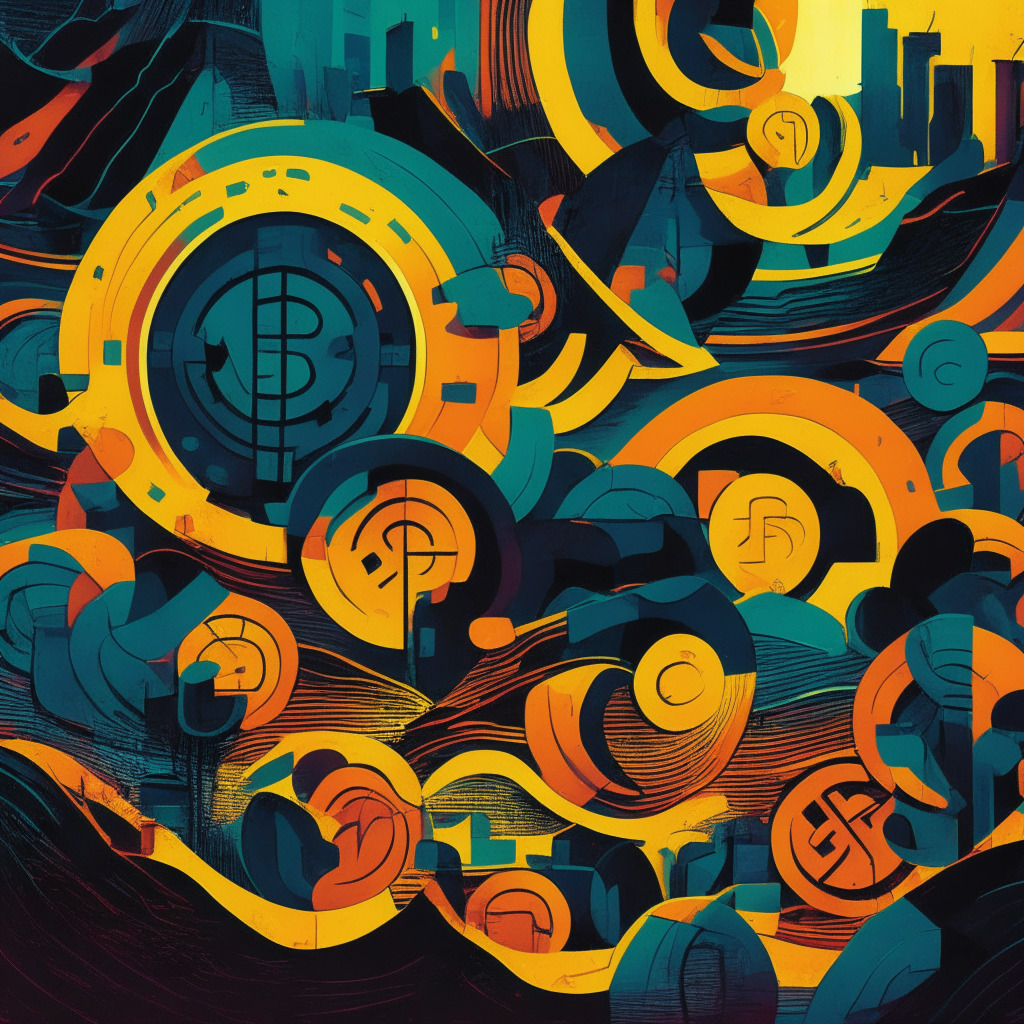Coinbase, a prominent cryptocurrency trading platform, is anticipating a successful Q2 earning despite legal challenges. However, a decrease in trading volume and concerns about its partner stablecoin, USD Coin (USDC), are casting shadows on its future. Nevertheless, the firm’s year-to-date performance shows a 173% growth. The SEC’s lawsuit overshadows, but recent legal victories provide a glimmer of hope.
Search Results for: USDC
Unpredictable Dance: Blockchain’s Global Developments and Regulatory Twists
These developments underscore an exciting time for blockchain technologies, highlighting the intricate dance between regulators and innovators. They illustrate the challenges that emerge in a rapidly evolving digital ecosystem. However, the future scope for blockchain seems expansive and unpredictable.
Coinbase Q2 Earnings: Bullish Analysts Defy FactSet’s Predicted Decline Amid Regulatory Challenges
Despite FactSet consensus projecting a decrease in Coinbase’s revenues, analysts anticipate a robust Q2 report, influenced by active retail trading and the U.S. District Court decision regarding XRP tokens and bitcoin ETF demand. However, factors such as potential court ruling reversal, regulatory concerns and Coinbase’s ongoing SEC lawsuit may affect the outlook.
Navigating Bitcoin’s 2023: Market Swings, Security Threats, and Cautious Optimism
Bitcoin is currently unstable due to recent U.S Federal Reserve’s lending rate hikes and a major security breach at Curve Finance affecting Ethereum pools. Despite this, experts still anticipate positive trends for bitcoin spurred by clearer global economic trends.
US Defense Bill’s Impact on Stablecoins: A Compliance Conundrum in the Offing
The U.S. national defense bill could pose compliance challenges for stablecoins like USDC due to proposed Know Your Customer (KYC) and anti-money laundering (AML) measures. The standards may affect stablecoin holders’ identities and impact USDC’s market cap. The bill’s implications could also affect Coinbase, which derived almost 27% of its net revenue from USDC in Q1 2021.
Ethereum Validators’ Jackpot: MEV Surge Amidst Curve Finance Exploit
“MEV rewards for Ethereum validators surge after an exploit on Curve Finance triggers a torrent of transactions on the blockchain. The increased transaction rate, due to concerns about crypto asset safety, leads to higher transaction fees and a subsequent rise in MEV, a form of gain from rearranging or adding transactions in a data block.”
Wyoming’s Revolutionary Leap: State-backed Stablecoin Project and a Hefty Paycheck Higher than the Governor’s
The US state of Wyoming plans to hire an executive director for a groundbreaking stablecoin project, a commission introduced after the Wyoming Stable Token Act was recently approved. The commission’s authority allows it to issue a US dollar-pegged stablecoin in Wyoming, redeemable for dollars in the state’s bank account. With desired qualifications including blockchain expertise and understanding of Wyoming’s legislative operations, the Commission aims to issue a stablecoin by end of 2023.
DeFi Protocol EraLend Robbed of $3.4M: A Wake-up Call for Blockchain Security
“EraLend, a Decentralized Finance (DeFi) Protocol, has lost $3.4 million in a ‘re-entrancy attack’. This incident underscores the need for advanced security protocols within blockchain transactions, highlighting how dependencies and vulnerabilities can be exploited.”
Backpedaling or Forward Leaping: Regulatory Uncertainty Puts Crypto Adoption at Crossroads
“Key U.S companies such as Nasdaq and Citigroup reconsider their stance on crypto due to regulatory uncertainty. However, others like Societe Generale and Schroders show a continued interest in crypto. Regulatory environments in the U.S and Europe contrast, with Europe taking a more embracive stance.”
Exploring the Era Lend Exploit: Urgent Lessons in Blockchain Security
“In the crypto world, security is paramount. Recently, lending app Era Lend on zkSync experienced a $3.4 million exploit due to a ‘read-only reentrancy’ bug. This exploit illustrates the need for advanced tools and strategies in bolstering blockchain security, highlighting the importance of extensive audit capabilities to prevent similar vulnerabilities.”
The Cryptosphere Revolution: How Elon Musk’s Vision for Twitter Could Reshape Crypto Payments
Tech billionaire Elon Musk’s vision of transforming Twitter and its potential of becoming a platform for payments, including cryptocurrency, has sparked speculation. Despite questions about Musk’s commitment to promoting crypto, incorporating crypto payments into Twitter might indicate a wider use initiation.
Era Lend on zkSync: Analyzing a $3.4 Million Security Breach’s Impact on the Future of Blockchain
“Era Lend, a lending protocol on the Ethereum scaling blockchain zkSync, experienced a significant security breach via a $3.4 million read-only reentrancy attack. This event led to a nearly 40% drop in its total locked capital, highlighting the ongoing issue of blockchain security vulnerabilities. However, incidents like these also provide essential lessons towards building a more resilient and secure blockchain ecosystem.”
Chinese Satellites and Blockchain: An Ornate Dance in Orbit and the Uncertain Fate of Cryptocurrencies Globally
“Chinese satellite, Tai’an Star Era 16, becomes the world’s first to carry a blockchain imaging and screening system into space. The ‘ADAChain’ system helps with multi-signature authentication, video visual broadcasting, and data storage certificate confirmation.”
The Rush and Restraint of Worldcoin’s WLD Token: A Crypto Standoff
“The crypto world was abuzz as giants like Binance, Huobi, Bybit, and OKX rushed to list the new Worldcoin’s WLD token, a brainchild of ChatGPT co-founder, Sam Altman. The token’s launch generated both excitement and skepticism, raising questions about its long-term sustainability.”
Stablecoins’ Struggle for Dominance Amid Market Turbulence: A Chronicle of Ups and Downs
The recent downturn in crypto markets has led to a decreased dominance of stablecoins, with the Pax Dollar (USDP) facing a significant decrease. Despite an overall reduction in the stablecoin market, there has been a surprising increase in stablecoin trading volumes. This turbulence in the crypto space continues to influence the stablecoin market.
Stellar Lumens (XLM) Glows amidst Crypto Market Surge: Risks and Rewards of Investment
Stellar Lumens (XLM) has shown a 24-hour surge, marking it as a top performer within the largest cryptocurrencies. This performance is complemented by Stellar’s alliance with Fonbnk, a project aimed at converting prepaid SIM cards into virtual debit cards and aiding Africa’s 350 million unbanked population.
Bitso and Stellar: Unleashing Financial Freedom or Inviting Cyber Threats?
“Latin American crypto exchange, Bitso, partners with Stellar’s Anchor Network to facilitate global trade in USDC across Argentina, Colombia, and Mexico. While such a partnership signals major progress, it equally amplifies concerns about market fluctuations, security vulnerabilities and potential for money laundering within the transnational operations of crypto exchanges.”
Aave’s GHO Stablecoin Accomplishes $2.5 Million Minting in Two Days: An Insightful Analysis
Aave’s new stablecoin GHO, backed by the Ethereum network, generated $2.5 million within 48 hours of its launch. It operates under the governance of the Aave DAO community and offers robustness and dynamism through over-collateralized assets. With the release of GHO, Aave’s total locked value increased significantly, highlighting the platform’s success and market growth.
Bridging the Gap: Gnosis Fuses Decentralized Payments with Visa’s Traditional Channels
Gnosis is pioneering the integration of decentralized payment systems with conventional channels, launching products allowing users to spend their digital assets from wallets via Visa’s system. Gnosis Pay and Gnosis Card, a self-funded Visa debit card connected to an on-chain wallet, aim to simplify the movement of crypto-assets and reinforce the Gnosis blockchain ecosystem.
Navigating the Uprising: How FSB’s Proposed Crypto Regulation Promises Market Stability
The Financial Stability Board (FSB) is advocating for a global digital asset regulation to ensure safety for user assets. The proposed regulations separate user assets from platform assets for transparency. They also aim to solidify stablecoin regulations, prevent commingling of user funds, and expect stablecoin issuers to establish an identifiable legal body to ensure accountability.
Crypto Regulation Spotlight: Mashinsky’s Detainment Fuels Debate on SEC Oversight and CFTC Role
Alex Mashinsky’s detainment on allegations of wire fraud, securities fraud, and price manipulation intensifies discussions on crypto regulation. Mashinsky’s case, alongside a ruling favoring Ripple, could have significant implications for platforms like Binance, Coinbase, and Bittrex that have faced SEC accusations. The situation underscores the need for a comprehensive regulatory regime to counter potential frauds in the crypto market.
Rise of Stablecoins: Will They Topple the US Dollar’s Dominance in the Digital Age?
“Jeremy Allaire, the CEO of Circle, warns of the risk to the US dollar’s status as the leading global reserve currency in the face of rising stablecoins. Allaire emphasizes the need to regulate stablecoins and develop trust in digital dollars, as cryptocurrency is poised to revolutionize the payment system, potentially saving a trillion-dollar economic toll from traditional financial system inefficiencies.”
Coinbase Revolutionizes Crypto with Encrypted Messaging: A Trend or Tryst?
“Coinbase announces its self-custody wallet will soon double as an encrypted messaging service, powered by XMTP—a web3-based decentralized communications network. This enables users to interact differently with their wallets, facilitating secure, personal transactions and extending the realm of cryptocurrencies.”
The Rise and Uncertainty of Centralized Stablecoins: Balancing Transparency and Dependence
Centralized stablecoins, stabilizing their price against another asset like the U.S dollar, account for 75% of all transactions on centralized crypto exchanges, with TrueUSD (TUSD) and Tether’s USDT taking significant shares. However, amid growth, controversies and transparency issues pose challenges and risks, demonstrating the crypto market’s vulnerability. The future of such stablecoins depends on addressing these vulnerabilities and embracing transparency.
Cryptocurrency Reserves Skyrocket: Bitget’s Financial Strength Vs. Transparency Questions and Bitcoin ETF’s Promise
“Cryptocurrency exchange Bitget boasts a total proof-of-reserves ratio of 223% across 31 crypto assets. Relying on transaction profits and investment returns, Bitget operates a $300 million User Protection Fund. Meanwhile, in Europe, London-based Jacobi Asset Management is set to launch its Bitcoin ETF, offering a significant departure from customary exchange-traded notes.”
Barclays versus Coinbase: A Tale of Contrasting Perspectives in the Cryptosphere
“Barclays downgraded Coinbase’s stocks from equal to underweight amidst uncertainty about the platform’s future. Despite declining metrics, Coinbase’s stocks rose following involvement in a BTC ETF application. The tug-of-war between market forces and regulatory constraints calls for prudence in cryptocurrency investments.”
Blockchain Gaming Revolution: Spielworks’ Refundable NFTs and the Balance of Innovation and Caution
Blockchain gaming startup Spielworks has partnered with Mycelium Network to create a refundable Non-Fungible Token (NFT) program. The NFTs, named “Reverties”, allow gamers to receive full refunds in USD Coin through a new minting mechanism. Additionally, interest from the decentralized finance lending pool contributes to environmental causes. However, potential challenges include the sustainability of the program and uncertainty over user reception of the new minting process.
Navigating the Crossroads: Pros and Cons of Crypto Regulation Amidst Ongoing Innovations and Concerns
“Crypto regulation remains a hot topic with structural flaws and potential benefits. The Bank for International Settlements criticizes crypto’s viability in the monetary system, while the UK Treasury suggests a five-year regulatory reprieve could benefit digital assets. However, controversies arise with technological advancements and perceived threats to decentralization principles by some pilots of Central Bank Digital Currency. Meanwhile, jurisdiction disputes in crypto markets begin.”
Unraveling the Multichain Mystery: Inside Job or Outsider Exploit?
“Cryptocurrency enthusiasts were alarmed by reports of Multichain’s suspicious withdrawals and possible internal fraud or “rug pull”. Questions arise over its administration’s integrity and security, highlighting the need for robust security measures, comprehensive internal protocols, and regulatory oversight in cryptocurrency platforms.”
Ethereum’s New Improvement Proposal: A Solution for Secure Token Bridging or Added Complexity?
Ethereum Improvement Proposal (EIP-7281), co-authored by Arjun Bhuptani, aims to standardize bridging of tokens between networks. This new protocol seeks to minimize risks like the recent Multichain incident by moving token ownership from bridges to issuers, thus limiting possible losses from bridge security breaches.
Navigating the MiCA Legislation: Impacts on Private Stablecoins and the Future of Crypto Regulation
The European Union enacted the Markets in Crypto-Assets (MiCA) legislation, sparking controversy with a daily 200 million euros transaction cap for private stablecoins. This is meant to protect investors from large-scale stablecoin failures which could impact traditional financial systems. However, critics argue it could stifle innovation within the crypto landscape.
Navigating Crypto-Waters: Blockchain Prospects Amid Rising Security Concerns
“Cybercriminals exploited a recent multichain attack to initiate a fake Twitter scheme linked to the distribution of Fantom’s FTM tokens. While the blockchain holds transformative potential, these incidents underline the need for cautious handling of links and emphasize the importance of cybersecurity in the digital asset realm.”































